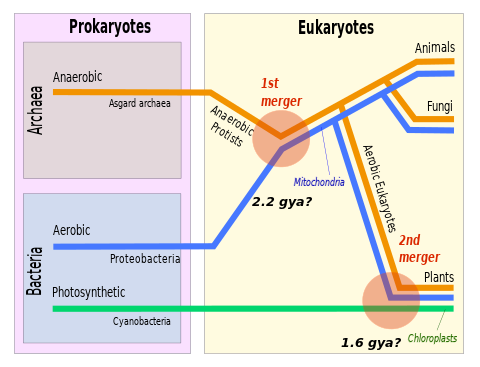
Symbiogenesis (endosymbiotic theory, or serial endosymbiotic theory[2]) is the leading evolutionary theory of the origin of eukaryotic cells from prokaryotic organisms.[3] The theory holds that mitochondria, plastids such as chloroplasts, and possibly other organelles of eukaryotic cells are descended from formerly free-living prokaryotes (more closely related to the Bacteria than to the Archaea) taken one inside the other in endosymbiosis. Mitochondria appear to be phylogenetically related to Rickettsiales bacteria, while chloroplasts are thought to be related to cyanobacteria.
The idea that chloroplasts were originally independent organisms that merged into a symbiotic relationship with other one-celled organisms dates back to the 19th century, when it was espoused by researchers such as Andreas Schimper. The endosymbiotic theory was articulated in 1905 and 1910 by the Russian botanist Konstantin Mereschkowski, and advanced and substantiated with microbiological evidence by Lynn Margulis in 1967.
Among the many lines of evidence supporting symbiogenesis are that mitochondria and plastids contain their own chromosomes and reproduce by splitting in two, parallel but separate from the sexual reproduction of the rest of the cell; that the chromosomes of some mitochondria and plastids are single circular DNA molecules similar to the circular chromosomes of bacteria; that the transport proteins called porins are found in the outer membranes of mitochondria and chloroplasts, and also bacterial cell membranes; and that cardiolipin is found only in the inner mitochondrial membrane and bacterial cell membranes.
- ^ Latorre, A.; Durban, A.; Moya, A.; Pereto, J. (2011). "The role of symbiosis in eukaryotic evolution". In Gargaud, M.; López-Garcìa, P.; Martin, H. (eds.). Origins and Evolution of Life: An astrobiological perspective. Cambridge: Cambridge University Press. pp. 326–339. ISBN 978-0-521-76131-4. Archived from the original on 24 March 2019. Retrieved 27 August 2017.
- ^ "Serial endosymbiotic theory (SET)". flax.nzdl.org. Archived from the original on 18 August 2021. Retrieved 8 March 2021.
- ^ Cite error: The named reference
:1was invoked but never defined (see the help page).